�
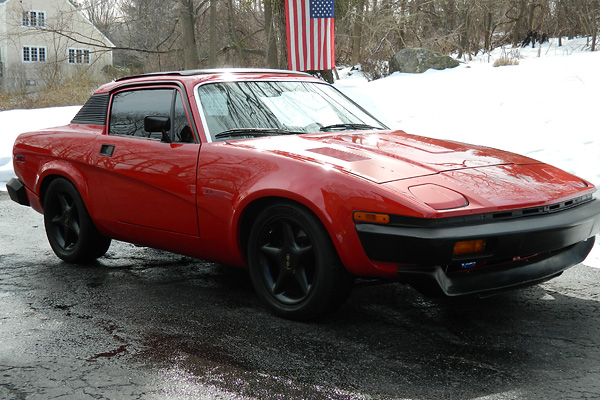
�
Lorenz Hassenstein's 1978 Triumph TR8 Coupe with Rover 4.6L V8
� as published in BritishV8 Magazine, Volume XXI Issue 1, July 2013�� � Owner: Lorenz Hassenstein
� BritishV8 UserID: Lorenz
� City: Ridgefield, Connecticut
� Model: 1978 Triumph TR8 coupe (chassis #108)
� Engine: Rover 4.6L V8
� Conversion by: owner
�
How It Was Done
��
Throughout the five or so years it took me to build my�
1968 MGB GT V8 track car,�
I forged a number of relationships with Triumph TR8 owners here on the East coast and�
finally decided to purchase a Wedge. �
�
I started by purchasing a disassembled vermillion red TR8 Coupe shell (air conditioned),�
car #108. It included an interior and "two of everything" or so I was told. The car had been�
disassembled and the previous owner never got around to putting it back together.�
I got the shell from Woody Cooper and we had his paint shop slap some Vermillion paint�
on it which seemed to make sense as it was already disassembled.�
�
I then purchased a drivetrain from Tim Lanocha. He had it in another car and had a buyer�
for the shell so he was willing to sell me the mechanicals. The purchase included�
a 4.6L Rover that was stock except for camshaft and lifters. The motor came with an open�
plenum intake, a Quick-Fuel double-pumper carb, and a set of headers. The transmission is�
a Tremec T5 out of a Modern Ford Mustang. The differential is a Ford 9" that was cut down to�
fit the TR8 and came with a 0.350 gear set. Lanocha also included shock absorbers, brakes,�
suspension, master cylinders, radiator, cooling fan, and six rims (2 for the front and 4�
for the back). All I had to do was put everything on the shell and take it for a spin.�
Simple, right?�
�
I decided to build the car and work out all the kinks and then go from there. It only�
took me a couple of months to put it together and as I put the last item on, the front�
bumper, I noticed the left front bumper mount was pushed in by an inch and there were two�
kinks in the frame rail on the same side. Once together the car looked like a crooked�
hammerhead shark. The lefthand fender was 3/4" higher than the righthand fender and the�
bumper certainly looked like a crooked smile. I wasn't a happy camper.�
�
I proceeded to drive the car and work out the mechanical kinks. I commuted in the car into and�
out of Manhattan throughout the summer. It took 100° heat in stop and go traffic for hours�
at a time on the West Side Highway and never skipped a beat. Over time, I started to list all�
the issues the car had. I was unsatisfied with the paint job. The brakes were crap. The suspension�
and springs were inadequate. I think there were three different brands of tires on the thing.�
There was lots of room for improvement to say the least. But I could see the potential and I�
loved that the TR8 is unusual. I resolved to purchase another shell and start over. �
�
I continued to drive the crooked TR8 and work out the kinks. Meanwhile I picked up a new TR8�
shell and stripped it. The new shell had been hit in the right rear and the repair job was�
poorly done, so I cut it out and repaired it properly. I also heard that the rear suspensions�
pulled away from the body under load and that the floor panels would separate under the seat�
due to torque. The suspension links were wrong from the factory, and I decided to box them�
in to help them resist twisting. I consumed three spools of welding wire in the process. A�
couple of months later, I had the shell cleaned up and primed. I boxed in the seat frames with�
1/4" plate and rolled the steel up the rear wall and stitched them into the rear control arm�
mount points. I also boxed in the upper and lower control arms on the rear suspension which�
together distributed the suspension load more evenly throughout the unibody. Finally, I created�
a strut brace to stiffen the front suspension which also serves as a mounting point for the�
remote brake/clutch reservoirs and radiator overflow yet doesn't interfere with the fresh air duct.�
�
�
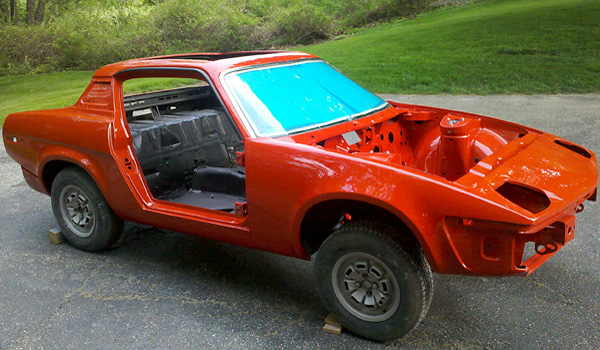
�
I got the replacement Triumph TR7 bodyshell into the bodyshop in December and it came back in February.
�
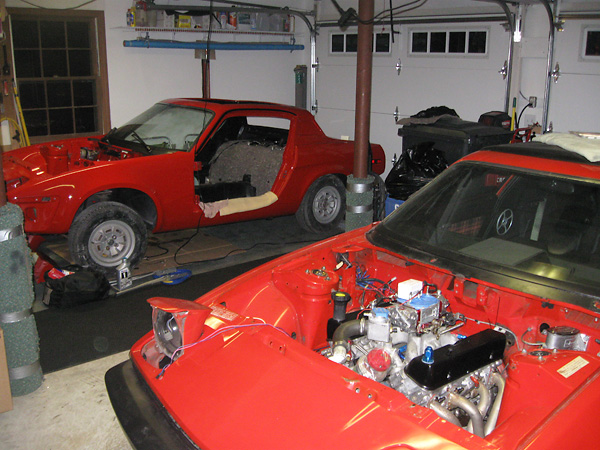
�
All I had to do now was swap everything from the running coupe to the newly restored body.
�
�
The interior and trunk were coated with black epoxy paint, and the entire underbody was coated�
with ceramic undercoating. The frame rails were all treated internally. It was an immaculate job.�
Best yet, all the modifications had been integrated into the new shell; �
�
However, during the swap I uprated a few things: brakes, suspension, fuel system, electronics,�
cooling, intake, interior, and gauges. I also added a few engine changes, just for fun. �
�
Fuel delivery mods started with a cleaned and treated tank. I also had the exterior of the tank�
powder-coated. I replaced the fuel level sender float and had a gravity feed port plumbed to an�
exterior mounted high-output racing fuel pump. Steel braided line and three fuel filters deliver�
the fuel to a pressure regulator inside the engine bay.�
�
Electrical wiring was a combination of the existing TR8 harness to handle the lights and a modern�
wiring harness to handle the MSD ignition, factory gauges, cooling fans, stereo, air conditioning,�
fuel, wide band O2 system, water/methanol injection system, and NOS systems. Quite a�
bit of work was needed to get my T5 transmission to work with a stock Triumph speedometer. I sent�
a TR7 (4-cylinder) the tach out to be modified to accept the signal from the MSD ignition. The TR7�
unit has a redline mark at 6,000 RPM.�
�
Cooling is handled by the oversized Ron Davis radiator Lanocha originally provided. He also provided�
a puller fan and fan shroud. I also had a 12" 3,200 CFM pusher left over from my MG track car so I�
mounted it up front. The puller fan is controlled by SPAL thermostatic controller. The two fans keep�
the car running at 160° no matter what. I also replaced the thermostat housing and mounted a new�
overflow tank. Finally I had the intake manifold modified to allow coolant to exit from the rear of�
the cylinder heads, bypassing the thermostat and continuing directly into the radiator. This helps the�
engine run cooler on the hottest of days.�
�
Spectre Performance has a great kit that includes everything you need to pull fresh air from�
the factory inlets into a dual-inlet plenum that I had powder-coated to match everything else�
on the car. The inlet jet for the Snow water methanol system is plumbed into the plenum directly�
over the primaries. �
�
Interior mods included a 5-point safety harness, new seats with orange plaid fabric, new carpet,�
mechanical oil and temperature gauges, a vacuum gauge for the crank case vacuum pump, a wide-band�
O2 gauge, a new top and I built a new rear deck to support two 5x7 speakers and subwoofer. An�
amplifier sits on the deck in the trunk.�
�
Finally I had a NOS system laying around for about 5 years that I thought would be put to good use on�
the TR. I sliced the spare tire compartment and halved its depth stitching it back together so you�
can't see it from behind the car. I then mounted two five pound bottles in the trunk and installed�
safety valves and bottle heaters which are fed from a fuse box in the trunk that also feeds the fuel�
pump. The solenoids are tucked under the tunnel and hidden from view. There's an activation�
switch under the dashboard and the system goes live via a full throttle switch activated by a small�
lever I welded to the throttle pedal. The system is set to deliver an additional 100 HP at the flywheel,�
which equates to 78 HP at the rear wheel.�
�
Wheels (one set for the front and two for the back) were powder coated and Hankook street tires were�
fitted. The spare set of rear rims now have super sticky Nitto NT01 DOT slicks mounted; they provide�
a 1.7 second, 60 foot time out of the hole. The street tires are pretty good as well. I opted for�
modest 205/50R15 front tires so the car would stop in the rain. The 225/45R15 rear street tires�
are a step down from the slicks they sell.�
�
Finishing touches included new badges and a pair of clear matte finish racing stripes down the hood�
and across and down the trunk. I have to fabricate new air conditioning compressor and crankcase vacuum�
pump mounting brackets this coming spring. I can't think of another thing to do to the car. It's fast,�
fun, safe and it turns more heads than many modern super cars that run through town. I love it. �
�
�
Features and Specifications
�| Engine: | �stock Rover 4.6L engine block (including cross bolted mains) and crankshaft.�
Stock Rover 4.0L pistons and connecting rods.�
Approximately 10.4:1 static compression ratio.�
Stock Rover cylinder heads (lightly modified) and valvetrain.�
Custom ground camshaft from PBM / Erson Cams.�
Copper head gaskets.�
ARP extended length head studs.�
Harcourt open plenum intake.�
Quick Fuel 650cfm double pumper carburetor.�
Snow water-methanol injection system.�
MSD distributor and spark plug wires.�
MSD Ignition with 3-stage retarder box.�
GZ Motorsport crankcase vacuum pump.�
Spectre Performance intake system.�
| �
| Cooling: | �Ron Davis aluminum radiator.�
Spal puller fan, controlled by thermostat.�
Spal pusher fan, manually switched.�
160° thermostat. | �
| Exhaust: | �four-into-one headers supplied by The Wedge Shop.�
Custom 2.5" X-pipe.�
Dual mufflers. | �
| Transmission: | �Tremec T5-speed.�
Tilton clutch.�
Tilton hydraulic throw-out bearing. | �
| Rear End: | �Ford 9".�
0.350:1 gears.�
Limited slip differential. | �
| Brakes: | �(master) Wilwood tandem master cylinder with remote reservoirs. Wilwood 2psi residual pressure valves. � (front) Wilwood 4-pot calipers and 11.75" vented rotors on 1.96" offset hats. (See below for details.) � (rear) Wilwood 4-pot calipers and 11.75" vented rotors. Wilwood adjustable proportioning valve. | �
| Front Susp.: | �fully adjustable front suspension.�
2.5" inside diameter, 8" length, 275#/in coil springs mounted on adjustable perches.�
KONI adjustable shock absorbers.�
Custom hub-centering lug pattern adapter rings.�
| �
| Rear Susp.: | �four link rear suspension, with angled (inward at rear) upper radius rods.�
2.5" inside diameter, 7" length, 275#/in coil springs mounted on adjustable perches.�
KONI adjustable shock absorbers.�
New droop straps. | �
| Wheels/Tires: | �American Racing 15" aluminum wheels, powdercoated black�
(front: 4x100mm lug pattern, rear: 5x114.3 lug pattern.)�
Hankook Ventus V2 (205/50R15) front tires.�
Hankook Ventus RS3 (225/45R15) rear tires, for street use.�
Nitto NT01 DOT rear slicks (225/45/15) rear tires, for track use. | �
| Interior: | �stock. | �
| Body & Paint: | �body restoration was completed in 2010.�
The undercarriage was sprayed with ceramic microsphere insulation-loaded paint.�
The color is Vermillion Red, with clear matte racing stripes. | �
| Electrical: | �Power Master 160 amp alternator. | �
| Chassis Dyno: | �304 BHP at 5,800rpm, 321 ft·lb at 3,800rpm without nitrous oxide. � 370 BHP at 5,300rpm, 422 ft·lb at 3,900rpm with nitrous oxide. | �
| Quarter mile: | �12.7s without nitrous oxide. 12.1s with nitrous oxide. | �
| Weight: | �2,846#. (Very heavy for a TR8, mostly due to rear suspension reinforcement.) | �
Engine Installation
��
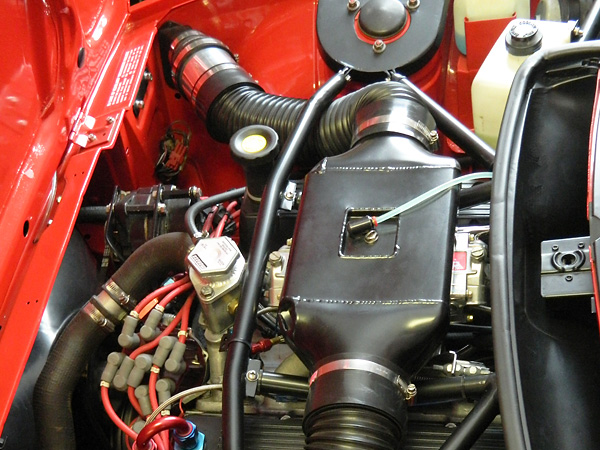
�
Lorenz built-up his engine and then had it fine tuned by Jeff Roell at Danbury Chassis Dyno.
�
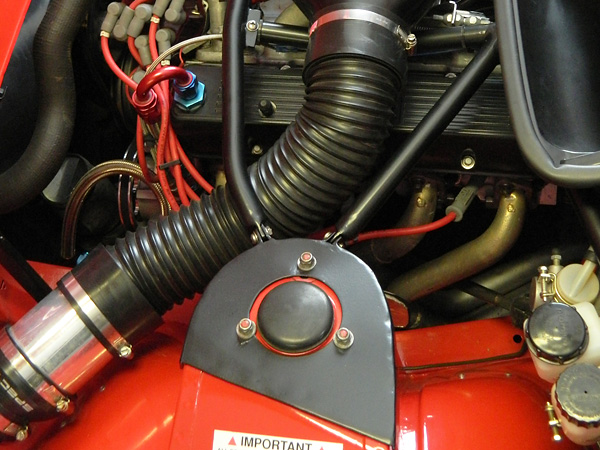
�
Exhaust headers were supplied by Woody Cooper.
�
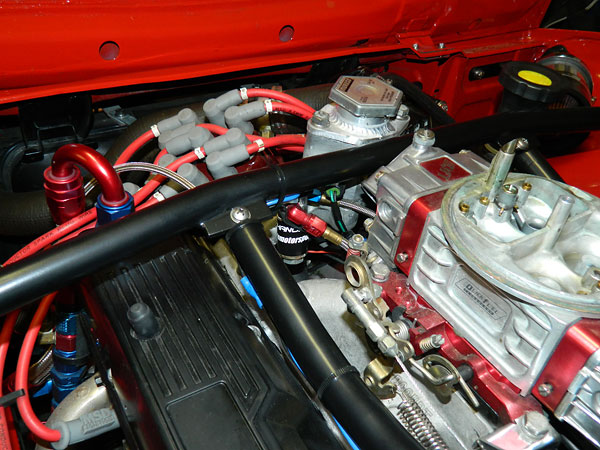
�
Quick Fuel 650cfm double pumper carburetor. (Note NOS plumbing.)
�
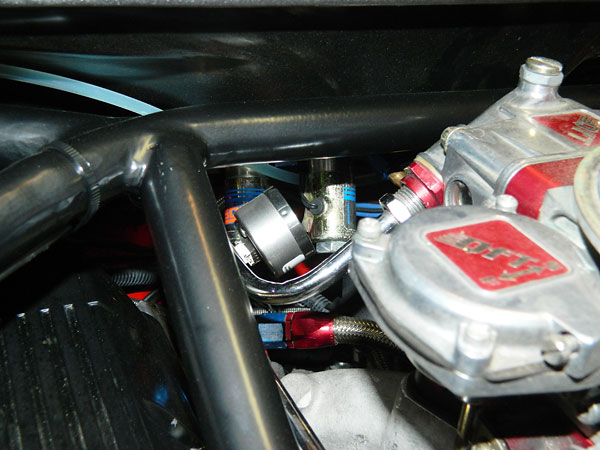
�
Fuel lines and choke mechanism.
�
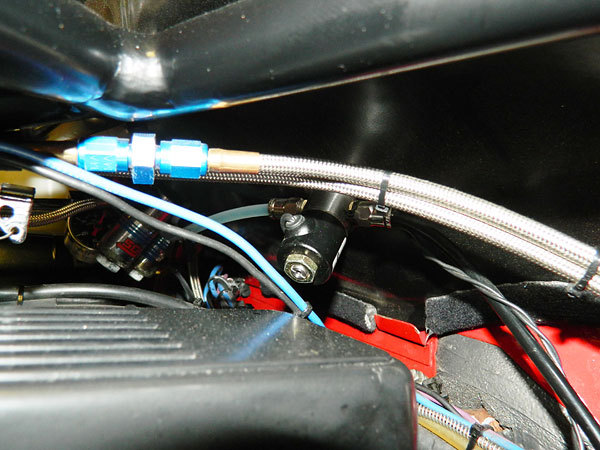
�
The Snow water/methanol injection system consists of reservoir, pump, control unit, safe
�
injection unit, solenoid, and jet. The solenoid (shown here) is mounted under the fresh
�
air intake and the jet is mounted above the primaries atop the plenum.
�
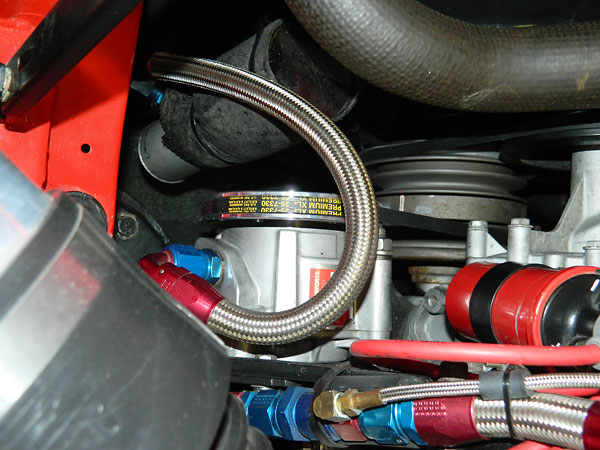
�
GZ Motorsport crankcase vacuum pump.
�
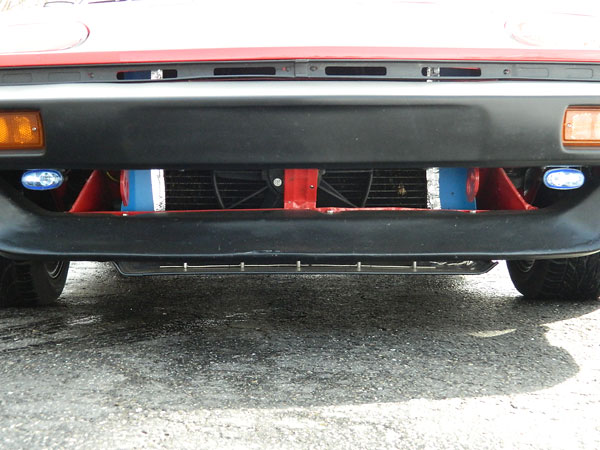
�
Ron Davis aluminum radiator. Spal pusher fan, manually switched.
�
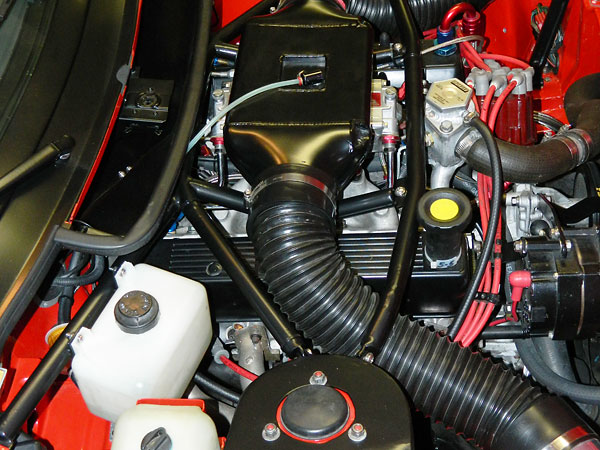
�
MSD distributor and spark plug wires.
�
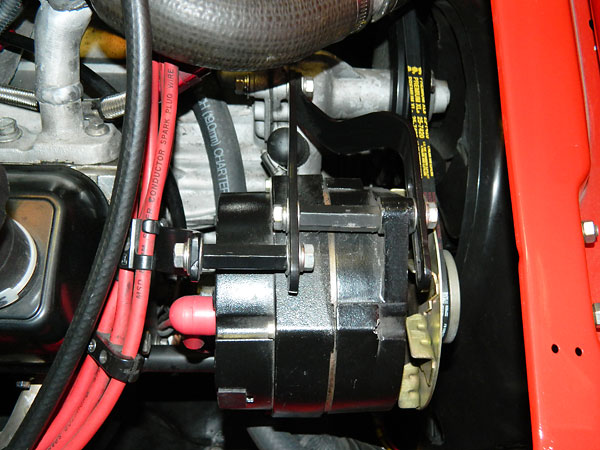
�
Power Master 160 amp alternator.
�
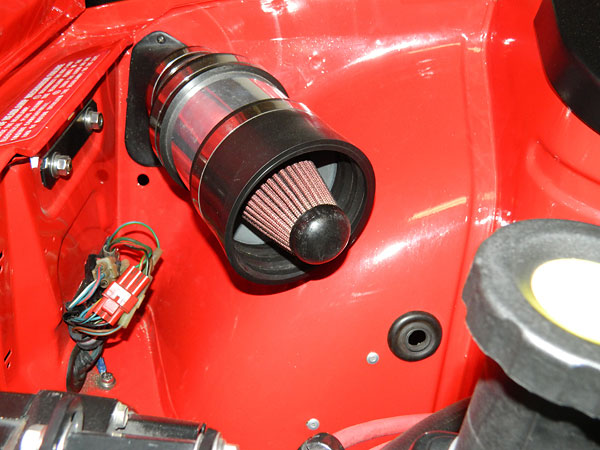
�
The Spectre intake system uses the TR8's factory cold air intakes. Air enters below the headlights
�
and runs to a pickups behind the fenders. Ducts in the engine bay house the filters and feed clean
�
air to the dual plenum. The low profile plenum fits under the hood without modification.
�
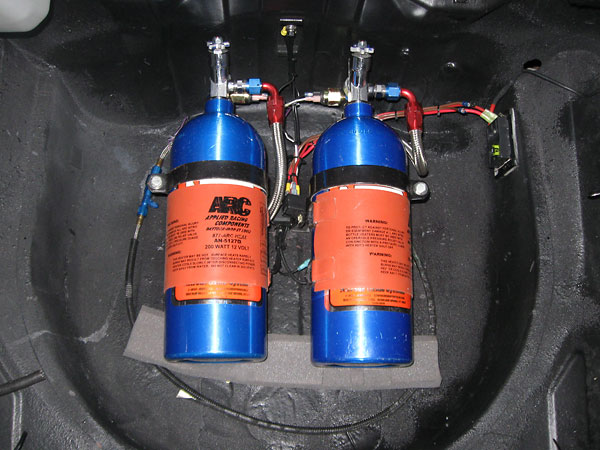
�
There are two 5# bottles of liquified nitrous oxide gas in the trunk. Electric blankets stir the
�
NOS to help keep the pressure up. "Arm" and "purge" switches are hidden under the center console.
�
A micro-switch mounted under the accelerator pedal triggers the system when the pedal is floored.
�
The MSD 3-stage retard box automatically retards ignition timing 5° as NOS is injected.
�
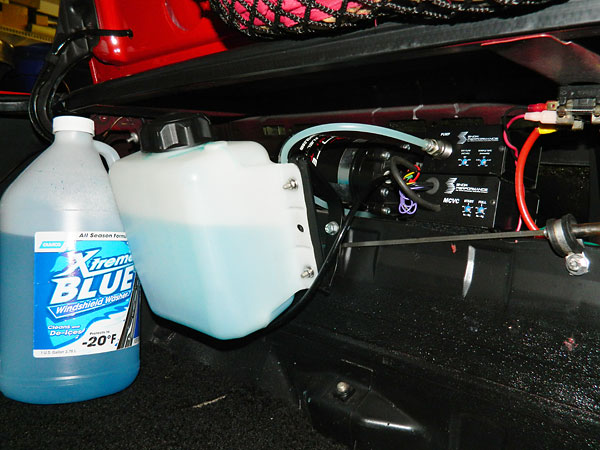
�
The Snow water/methanol injection system's reservoir, pump, controller and safe injection units
�
are all mounted in the trunk. The system triggers off of a tachometer signal and spray volume
�
varies with intake manifold vacuum. The system uses blue windshield washer fluid.
�
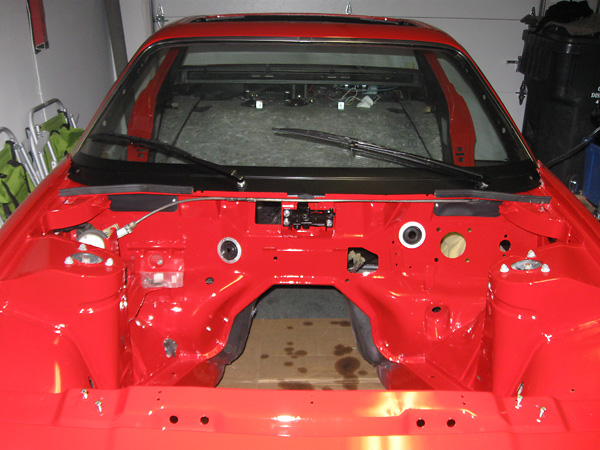
�
Very modest firewall modifications.
�
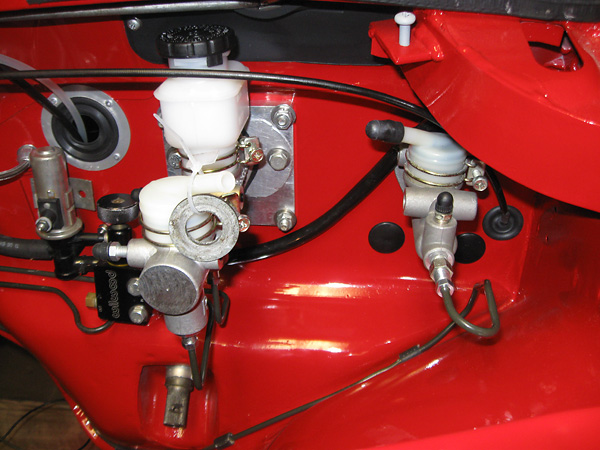
�
Lorenz initially built this car with an integral-reservoir Wilwood master cylinder. It conflicted with his
�
custom strut tower brace. He switched to a master cylinder with provisions for remote reservoirs,
�
(Wilwood master cylinder part# 260-8794. Reservoir part# 260-7577.)
�
The clutch master cylinder reservoir is also remotely mounted.
�
�
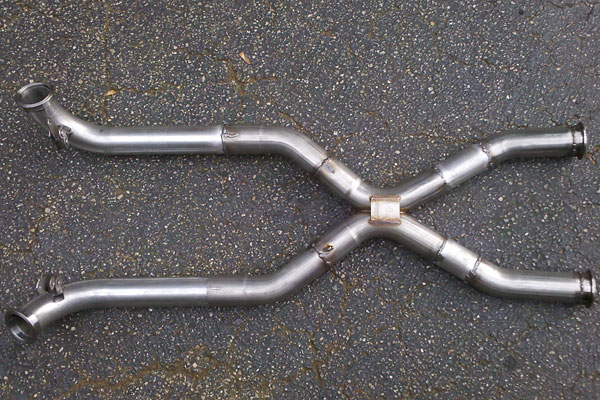
�
Custom 2.5" X-pipe.
�
Suspension and Brakes
��
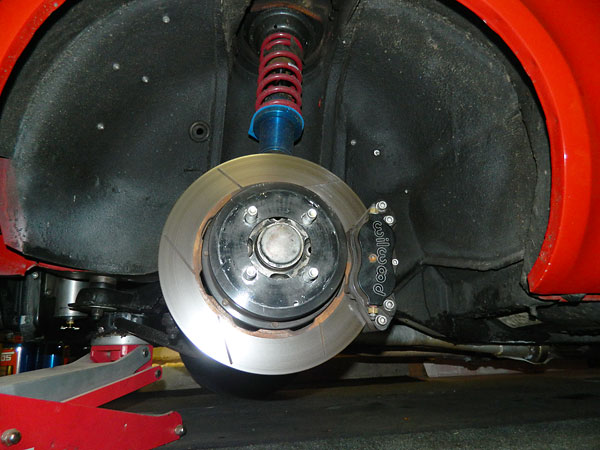
�
275#/in springs and KONI shock absorbers. Wilwood 4-pot calipers with 11.75" vented rotors
�
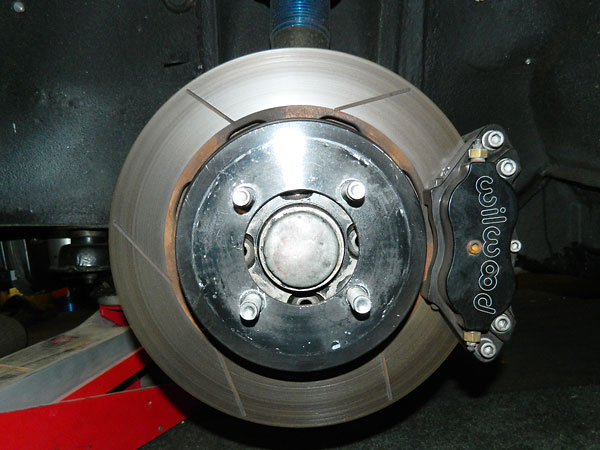
�
Stock Triumph TR7/TR8 hubs feature a 4x3.75" lug pattern, which severely limits wheel and
�
brake upgrade options. Lorenz solved this problem with custom 4x100mm hub adapters.
�
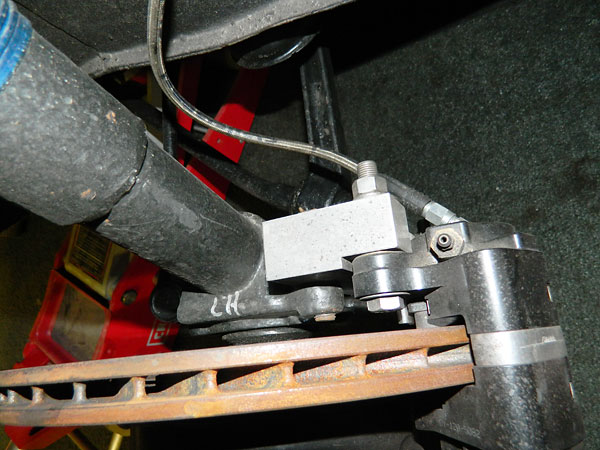
�
Wilwood Dynolite forged calipers (#120-5082), custom billet aluminum caliper mounts, 11.75" rotors
�
(#160-9009 and #160-9010), 1.96" offset rotor mounting hats with 8 holes on 7" circle for rotors but
�
undrilled for wheel lugs (#171-3753), rotor bolts (#230-0233D), street/strip brake pads (#150-8850K),
�
braided stainless steel brake lines #220-9101, and stainless steel "-3" 90 degree swivel fittings
�
to point the brake lines down from the body.
�
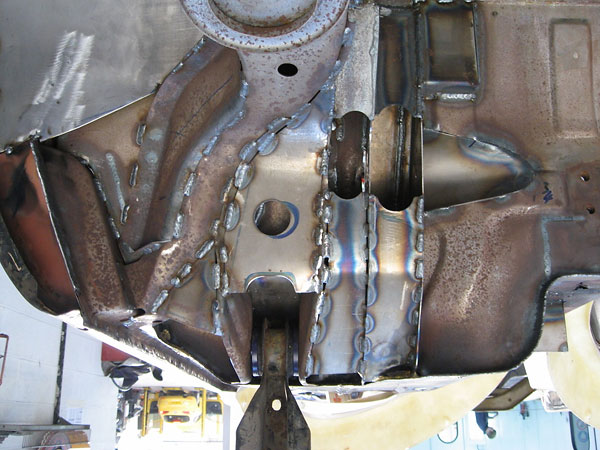
�
Substantially reinforced rear suspension attachment points.
�
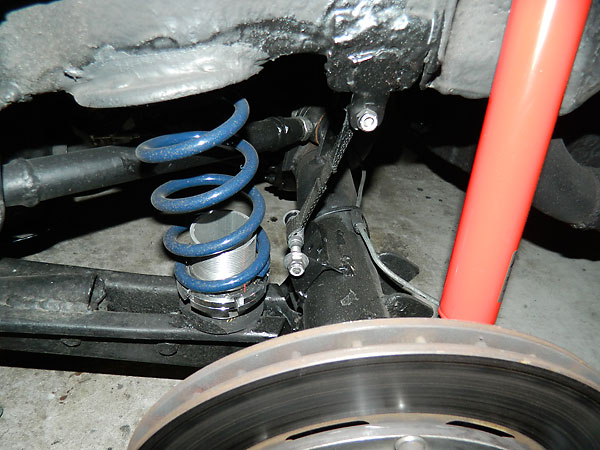
�
275#/in coil springs on adjustable perches. KONI adjustable shock absorbers. New droop straps.
�
�
Enjoying this article? Our magazine is funded through the generous support of readers like you!
�
To contribute to our operating budget, please click here and follow the instructions.
�
(Suggested contribution is twenty bucks per year. Feel free to give more!)�
�
Interior
��
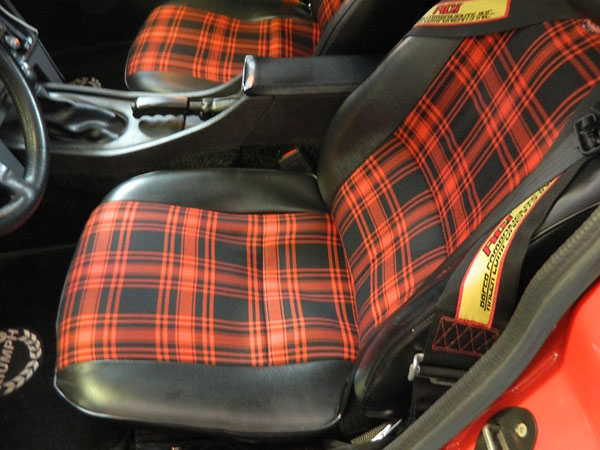
�
Triumph TR7/TR8 plaid upholstery
�
�
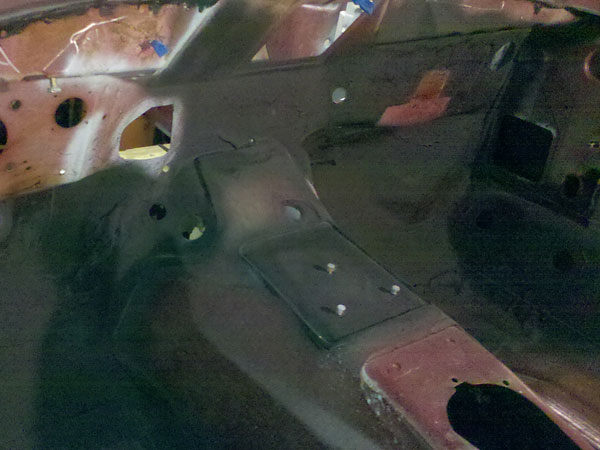
�
Sprayed-on sound and heat insulation with ceramic microspheres.
�
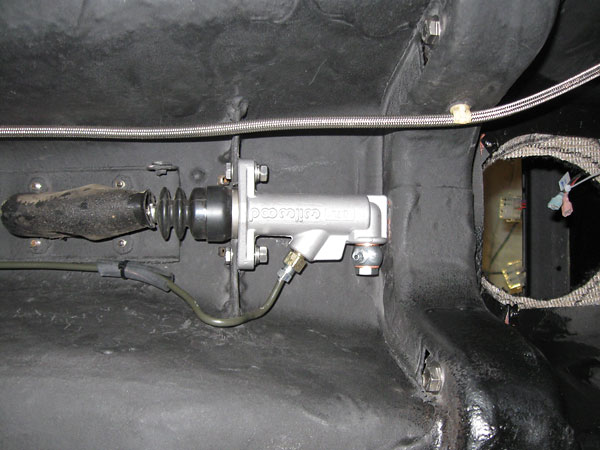
�
Wilwood 0.75" flow-through parking brake master cylinder plumbed into the rear brake line downstream
�
of the proportioning valve. It won't hold pressure forever but it's fine for short-term use.
�
Exterior
��
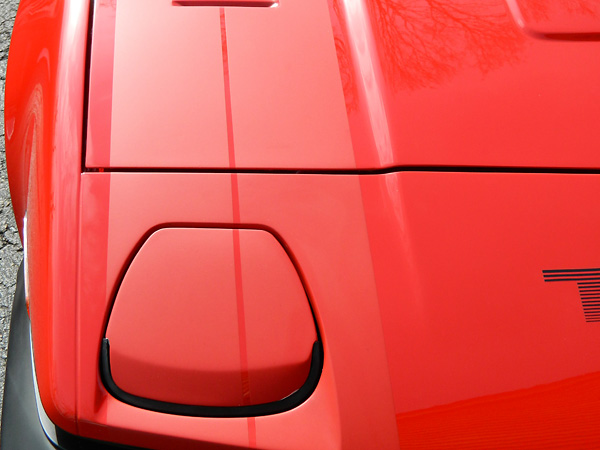
�
Pop-up headlights.
�
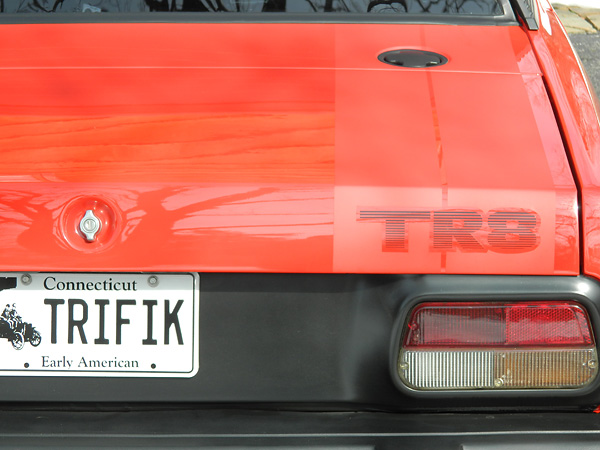
�
Recessed fuel filler cap.
�
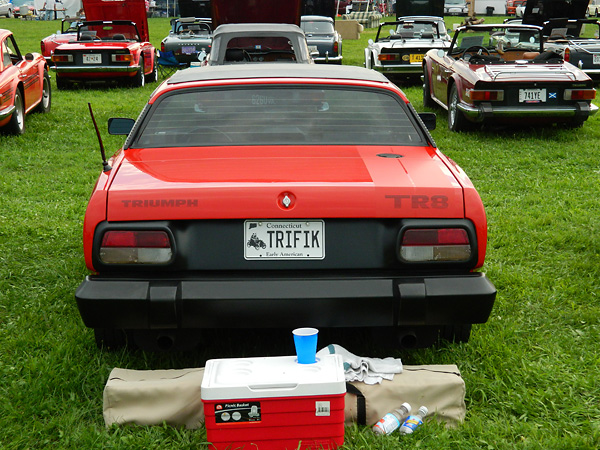
�
Vermillion Red paint with clear matte racing stripes applied by Julio Grosso in Danbury, CT.
�
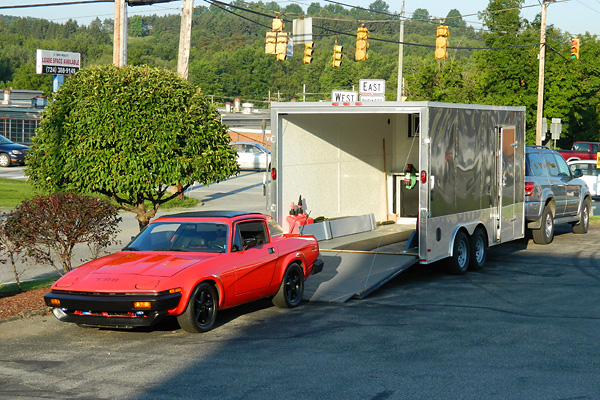
�
Although the Triumph TR7 was mainly produced as a coupe (i.e. with a fixed, steel roof), most Triumph TR8s were
�
convertibles. British Leyland committed to build 500 Triumph TR8 coupes to meet homologation requirements for
�
F.I.A. rally racing, but production ceased in 1980 long before that milestone was reached. Assembled in August
�
1977, Lorrenz Hassenstein's 1978 Triumph TR8 coupe is number 108 of only approximately 130 produced.
�

